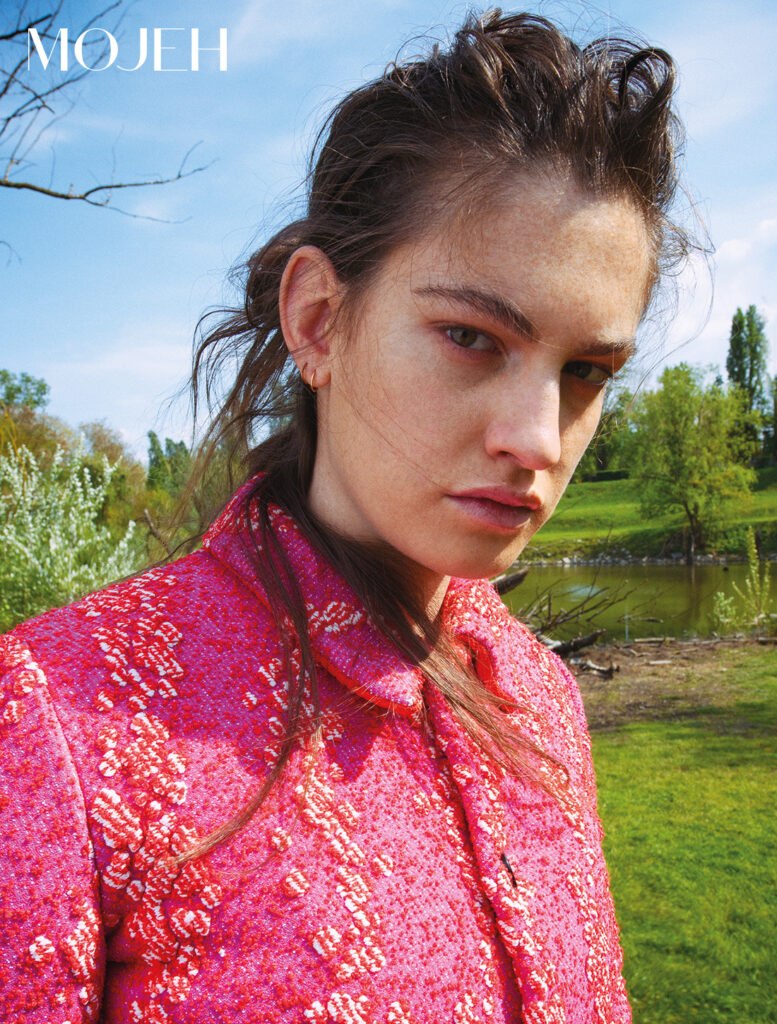From too much oestrogen to vitamin deficiencies, hormonal imbalances and not your beauty routine could be to blame for a range of skin issues
Feel bloated after eating certain foods? Hormones. Feel a little bit more weepy than usual and you can’t quite explain why? Hormones. Feel like your skincare has stopped working and you suddenly have the kind of acne that’s more Gen Z than TikTok? Well, you can see where we’re heading with this: hormones. Our hormones take a lot of flack, and while they might not always be to blame for our ills, they do have a huge bearing on how we feel and how our body responds to internal and external factors.
Essentially the body’s chemical messenger system, hormones travel in the bloodstream to our tissue and organs and affect everything from growth and development to metabolism, libido, mood and reproduction. They’re not just a female affliction either. Too much oestrogen in males can result in infertility, persistent fatigue and night sweats, while too much testosterone goes hand-in-hand with headaches, high blood pressure and excessive body hair. But back to the skin—optimising your complexion is a lot more complex than the adage: cleanse, tone, moisturise. Discovering what lies beneath rather than focussing on external factors is often the key to targeting specific skin issues like rosacea, cystic acne and pigmentation.

Photographed by Marc Guerrero for MOJEH 90
Acne
“Our skin is covered in small glands called sebaceous glands that secrete an essential oil called sebum which helps keep your skin healthy,” explains Sharin Shafer, COO from aesthetics clinic Skinfluencer in London. “These glands have receptors on them which respond to your hormones, including oestrogen and testosterone. Sebaceous glands are very sensitive to androgens like testosterone. The more androgens in your blood, the more they bind to your sebaceous glands—causing you to produce more oil.” Shafer explains that it’s very common for women to experience acne, especially the week before menstruation because of dropping oestrogen levels. She also says that women transitioning into menopause can also experience dry or itchy skin as well as sagging and wrinkling for the very same reason.
Dr Shadan Naji, Dermatologist at Dr Kayle Aesthetic Clinic, Dubai agrees that hormones have a direct impact on the skin and elaborates that acne has a direct relationship with hormones. “Adult female acne is triggered principally by hormonal imbalance. This type of acne affects mainly the lower face, the chin and jawline area.” Shafer adds that acne face mapping allows you to identify a specific area on the face with the cause of the breakout. “The jawline and chin are sensitive to hormones— women may see their chins erupt as hormones ebb and flow during their menstrual cycles. Compared to typical T-zone pimples, acne here is likely to be deeper, bigger and more inflamed,” she explains. “Rosacea [a skin condition that can cause redness, visible blood vessels and small, puss-filled bumps] can be affected by the hormonal changes that occur during a woman’s menstrual cycle or during perimenopause. Regulating hormone levels can help t o reduce the occurrence of rosacea flare ups.”
Pigmentation
Also known as melasma (and sometimes referred to as chloasma when it occurs during pregnancy), hormonal pigmentation is a chronic skin-pigment disorder that’s most commonly seen in the skin anywhere from the age of 20 through to 40. “Hormonal pigmentation, as the name suggests, is a skin condition that is caused by an imbalance in the hormones and results in the change of the skin colour from normal to a patchy and brown. It is more prevalent in African and Asian women as compared to others, although it can affect women of any race,” Shafer details. Grainne Sullivan, Regional Clinic Manager at Skin Laundry MENA adds that melasma is one of the most challenging skin conditions to treat and appears as dark irregular patches which are commonly found on the upper cheek, nose, lips, upper lip, and forearm. “These patches usually develop gradually over time and do not cause concern for any other symptoms beyond cosmetic discolouration. With melasma, there are numerous factors to consider, as well as underlying conditions that trigger hormonal responses.” She adds that melasma is commonly found in pregnant women, women taking oral contraceptives, or women on hormone replacement therapy (HRT).
In pregnant women, melasma tends to fade post-partum, but can return with subsequent pregnancies. “The discolouration will usually disappear over a period of several months after giving birth. On the other hand, melasma caused by oral contraceptive use typically does not fade after discontinuing use of the drug. Polycystic ovaries are also commonly associated with triggering melasma in women. The process of inflammation is a contributing factor to post-inflammatory hyperpigmentation.” Sullivan shares that when treating inflamed acne or dark skin phototypes, reducing inflammation and inflammatory responses of white blood cells should be considered in order to reduce risk factors to post-inflammatory hyperpigmentation. “Women are most affected by pro-inflammatory responses and the effects of androgens in the body and are more susceptible to adrenal hormone stimulation. The effects of androgens in the body should be considered as a risk factor to post-inflammatory hyperpigmentation,” she continues.

Photographed by Francesco Vincenti for MOJEH 86
Ageing
While many women turn to fillers and anti-wrinkle injectables to combat the signs of ageing, targeting hormonal imbalances can also help, as Sullivan reveals: “With age, the body produces lower levels of hormones and hormones lose their ability to communicate messages. This miscommunication can cause an imbalance in the endocrine system, accelerating the ageing process. Hormone miscommunication can occur when the body is under constant physical and emotional stress.” These include excess blood glucose which destroys collagen reserves that naturally start to deplete after the age of 25, excessive free radicals from pollution or smoking that can result in oxidative damage to cells, an increase in insulin resistance which causes the body to stop recognising insulin, and increased cortisol levels, the stress hormone, which can increase blood sugar and lead to acne, weight gain around the midsection, rounding of the face and muscle weakness.
External Factors
Milk and foods with a high sugar content can cause a rise in insulin levels, altering other hormones that can affect the skin, while foods with a high glycemic index (think bread and pasta) have been linked to acne. “Diets rich in fruit and vegetables are really good for your skin,” Shafer advises. “It’s also important to make sure you’re getting enough omega-3 fats (like oily fish) to reduce inflammation and help keep your skin clearer.” Dr Naji warns against nutritional supplements, which can alter hormonal balances. “Diet has a very important role as there are many supplements especially bodybuilding ones that include hormonal substances in their chemical makeup and these can trigger new breakouts,” she explains.
Edwige Gandin, a facialist at Pastels Salon Dubai believes a lot of skin conditions can be linked to poor gut health. “Poor gut health is linked to inflammation, which is the root of many health issues including hormonal imbalances, which can have acne as a side effect. By making your immune system work overtime, an unhealthy gut can affect your hormone levels. An unhealthy gut can be caused by caffeine and alcohol. When too much caffeine is consumed it increases the amount of stress hormones the adrenal glands produce.” Sullivan has this advice: “Increasing water intake, reducing intake of saturated fats and processed food, as well as choosing organic hormone free products where possible will all help, however unfortunately stress is one of the main factors that affects hormone level, therefore a balance of exercise is also a key component in managing the side effects.” She also believes protection from the outside environment is essential. “SPF, AHA’S and topical Retinol are essential to help shield the skin from free radicals and repair barrier function.”

Photographed by Tareck Raffoul for MOJEH 90
Diagnosis And Treatment
As the old adage goes, prevention is often better than cure but hormonal imbalances manifesting themselves as skin complaints can often be resolved via different treatments, some more invasive than others. “If you do suffer from acne, it is vital to schedule regular deep cleansing facials as this will keep the pores as clean as possible,” Gandin shares. It’s a sentiment shared by Shafer who champions salicylic acid, benxoyl peroxide and retinol. “The best cleansers for women with hormonal acne include a low percentage of salicylic acid—for instance a concentration of 0.5 per cent can help unclog the skin pores with over-drying the skin. Topical treatments, such as retinoids, antibiotics and anti-inflammatories, as well as salicylic acid or benzoyl peroxide, may also be used to treat hormonal acne.” As rosacea and pigmentation are both chronic conditions that require management by a skincare expert, Shafer advises that laser and more invasive treatments are often the only way to deal with treatments. At Skinfluencer these include growth factor PRP, chemical peels, fractional laser resurfacing, energy-based microneedling with controlled radio frequency heating, and prescription strength creams. These address the causes and side effects of acne to even out skin tone, tighten open pores, and also clear blackheads and whiteheads.
Sullivan also endorses lasers for, well, everything: from acne to ageing. “Laser is one of the only options, bar medication, to help treat these aforementioned issues at a cellular level,” she says. “Q Switch lasers penetrate into the dermal layer, using a very controlled beam of energy converted into heat to target overactive melanocytes. The laser breaks up unwanted pigmentation to allow it to be absorbed into the lymphatic system and removed from the body. For Acne, the laser kills any bacteria on the surface, removes dead skin cells and minimises excess oil. The laser penetrates into the skin to calm inflammation and stimulate healthy cell turnover to allow for new skin to regenerate and aid healing. To improve skin texture and tone and give a more youthful appearance, the laser stimulates fibroblasts in the dermal layer to thicken collagen, and strengthen and lift the skin from the deeper layers.”
Read Next: Dermal Filler Experts Teoxane Arrive In The Middle East
- Words by Aoibhinn Mc Bride





